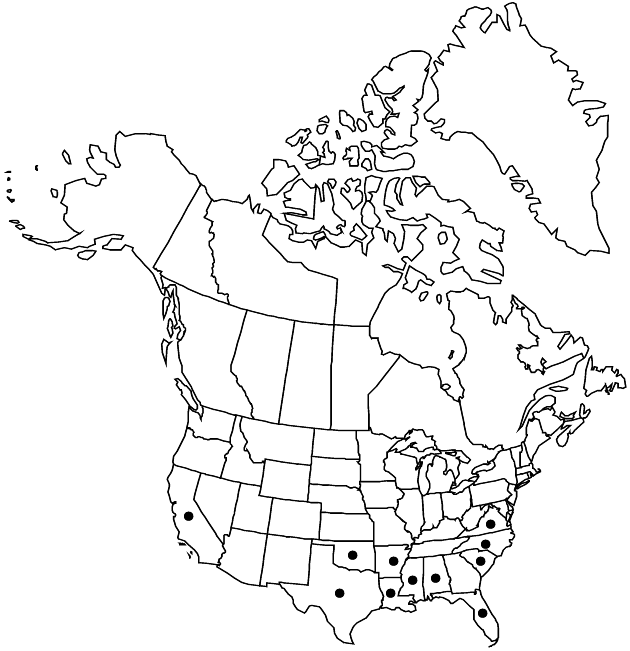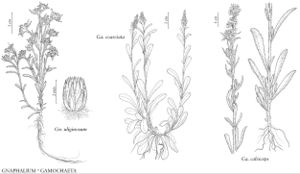Difference between revisions of "Gamochaeta calviceps"
Bol. Soc. Argent. Bot. 9: 368. 1961.
FNA>Volume Importer |
FNA>Volume Importer |
||
| Line 7: | Line 7: | ||
|year=1961 | |year=1961 | ||
}} | }} | ||
| − | |basionyms={{Treatment/ID/ | + | |basionyms={{Treatment/ID/Basionym |
|name=Gnaphalium calviceps | |name=Gnaphalium calviceps | ||
|authority=Fernald | |authority=Fernald | ||
| + | |publication_title=Rhodora | ||
| + | |publication_place=37: 449, plate 405, figs. 1–4. 1935 (as calvescens) | ||
}} | }} | ||
|synonyms= | |synonyms= | ||
| Line 51: | Line 53: | ||
|publication year=1961 | |publication year=1961 | ||
|special status= | |special status= | ||
| − | |source xml=https://jpend@bitbucket.org/aafc-mbb/fna-data-curation.git/src/ | + | |source xml=https://jpend@bitbucket.org/aafc-mbb/fna-data-curation.git/src/f6b125a955440c0872999024f038d74684f65921/coarse_grained_fna_xml/V19-20-21/V19_719.xml |
|tribe=Asteraceae tribe Gnaphalieae | |tribe=Asteraceae tribe Gnaphalieae | ||
|genus=Gamochaeta | |genus=Gamochaeta | ||
Revision as of 18:38, 24 September 2019
Annuals, 8–45(–55) cm; taprooted or fibrous-rooted. Stems erect, ascending (usually branched ± throughout), subpannose (hairs silver-gray, longitudinally arranged). Leaves mostly cauline, basal usually withering before flowering, blades spatulate to oblanceolate, mostly 2–6 cm × 2–9 mm (becoming linear-oblanceolate to linear distally, commonly folded along midveins), faces concolor or weakly bicolor, subpannose (hairs closely appressed). Heads initially in continuous or interrupted, spiciform arrays, 2–4 cm × 8–12 mm (pressed), later in paniculiform arrays 4–18 cm (main axes usually visible between heads, peduncles usually evident). Involucres campanulate, 3–3.5 mm, bases usually glabrous or glabrate. Phyllaries in 5–7 series, outer ovate-triangular, lengths 1/3–1/2 inner, apices acute-acuminate (involute and spreading to recurved), inner oblong, laminae slightly brown (not purple), apices obtuse-apiculate. Florets: bisexual 2–4; all corollas purple distally. Cypselae (tan) 0.4–0.5 mm.
Phenology: Flowering (Apr–)May–Jul.
Habitat: Disturbed sites, sandy or clay soils, roadsides, fields, clearing and edges of woods, flower beds
Elevation: 0–500 m
Distribution

Ala., Ark., Calif., La., Miss., N.C., Okla., S.C., Tex., Va., South America, Europe, Pacific Islands (New Zealand).
Discussion
Gamochaeta calviceps is recognized by its subpannose cauline and foliar indument (perhaps intermediate between the looser tomentum of G. antillana and the tight, pannose covering of G. argyrinea) and the contrast of its spatulate proximal leaves with the much narrower cauline ones, glabrous or glabrescent involucres, and phyllaries in 5–7 series, lacking purple color, the outer and mid with acute-acuminate apices commonly becoming subulate (by inrolled margins). The distal cauline leaves usually are folded along the midveins (at least when pressed). The relatively late flowering also is distinctive. Plants on the Atlantic coastal plain usually produce 2–3 bisexual florets per head, those on the Gulf coast 3–4.
Heads of older plants are borne in paniculiform arrays resulting from development of lateral branches, the heads usually on evident peduncles and with very little tomentum at the base of the outer phyllaries, thus appearing discrete. In early-season plants, lateral branches may not have formed or lengthened and the arrays of heads may appear continuous-cylindric at stem apices; in such plants, the species can usually still be recognized by the relatively numerous, relatively shorter, axillary shoots along the main stems.
Selected References
None.
